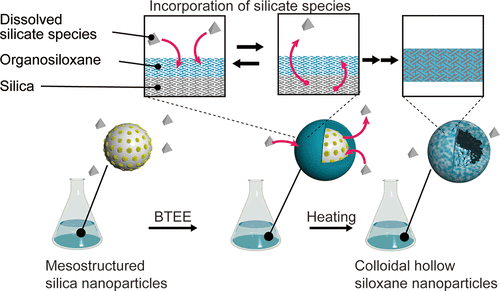当前位置:
X-MOL 学术
›
Chem. Mater.
›
论文详情
Our official English website, www.x-mol.net, welcomes your
feedback! (Note: you will need to create a separate account there.)
Transformation of Mesostructured Silica Nanoparticles into Colloidal Hollow Nanoparticles in the Presence of a Bridged-Organosiloxane Shell
Chemistry of Materials ( IF 7.2 ) Pub Date : 2018-01-11 00:00:00 , DOI: 10.1021/acs.chemmater.7b04860 Eisuke Yamamoto 1 , Saki Uchida 1 , Atsushi Shimojima 1 , Hiroaki Wada 1 , Kazuyuki Kuroda 1, 2
Chemistry of Materials ( IF 7.2 ) Pub Date : 2018-01-11 00:00:00 , DOI: 10.1021/acs.chemmater.7b04860 Eisuke Yamamoto 1 , Saki Uchida 1 , Atsushi Shimojima 1 , Hiroaki Wada 1 , Kazuyuki Kuroda 1, 2
Affiliation

|
Hollow siloxane-based nanoparticles (HSNs) have attracted significant attention because of their unique properties and applications. Recently, it was discovered that the simple covering of silica nanoparticles with an organosiloxane shell leads to the spontaneous formation of HSNs; however, the detailed mechanism of their formation has not yet been established. In this study, colloidal 30 nm HSNs were prepared by adding organically bridged alkoxysilane to an aqueous dispersion of mesostructured silica–surfactant composite nanoparticles, and the temporal changes of the morphology and chemical state of the nanoparticles were monitored to elucidate the formation mechanism. Core silica was dissolved after the formation of the core–shell structured nanoparticles, and almost all the dissolved silicate species were incorporated in the organosiloxane shell, changing the shell thickness. Two conditions were essential for silica dissolution induced by covering with organosiloxane: (i) presence of a sufficient amount of uncondensed Si–OH groups in the organosiloxane shell, and (ii) elevated temperature and pH for the promotion of the hydrolysis of silica. These findings will enable the fabrication of various HSNs through organosiloxane-induced silica dissolution and redeposition.
中文翻译:

存在桥有机硅氧烷壳的介孔结构二氧化硅纳米粒子到胶体空心纳米粒子的转化。
中空的硅氧烷基纳米颗粒(HSNs)由于其独特的性能和应用而备受关注。最近,发现用有机硅氧烷壳简单覆盖二氧化硅纳米颗粒会导致自发形成HSN。但是,其形成的详细机制尚未建立。在这项研究中,通过将有机桥接的烷氧基硅烷添加到介孔结构的二氧化硅-表面活性剂复合纳米颗粒的水分散体中来制备胶体30 nm HSN,并监测纳米颗粒的形貌和化学状态随时间的变化以阐明其形成机理。形成核壳结构的纳米粒子后,溶解了二氧化硅核心,几乎所有溶解的硅酸盐物质都掺入了有机硅氧烷壳中,从而改变了壳的厚度。对于通过覆盖有机硅氧烷而引起的二氧化硅溶解,两个条件是必不可少的:(i)有机硅氧烷壳中存在足够数量的未缩合的Si-OH基,以及(ii)升高的温度和pH值以促进二氧化硅的水解。这些发现将使得能够通过有机硅氧烷诱导的二氧化硅溶解和再沉积来制造各种HSN。
更新日期:2018-01-11
中文翻译:

存在桥有机硅氧烷壳的介孔结构二氧化硅纳米粒子到胶体空心纳米粒子的转化。
中空的硅氧烷基纳米颗粒(HSNs)由于其独特的性能和应用而备受关注。最近,发现用有机硅氧烷壳简单覆盖二氧化硅纳米颗粒会导致自发形成HSN。但是,其形成的详细机制尚未建立。在这项研究中,通过将有机桥接的烷氧基硅烷添加到介孔结构的二氧化硅-表面活性剂复合纳米颗粒的水分散体中来制备胶体30 nm HSN,并监测纳米颗粒的形貌和化学状态随时间的变化以阐明其形成机理。形成核壳结构的纳米粒子后,溶解了二氧化硅核心,几乎所有溶解的硅酸盐物质都掺入了有机硅氧烷壳中,从而改变了壳的厚度。对于通过覆盖有机硅氧烷而引起的二氧化硅溶解,两个条件是必不可少的:(i)有机硅氧烷壳中存在足够数量的未缩合的Si-OH基,以及(ii)升高的温度和pH值以促进二氧化硅的水解。这些发现将使得能够通过有机硅氧烷诱导的二氧化硅溶解和再沉积来制造各种HSN。


















































 京公网安备 11010802027423号
京公网安备 11010802027423号